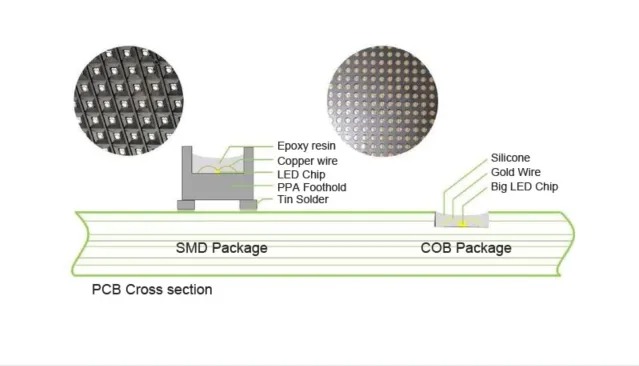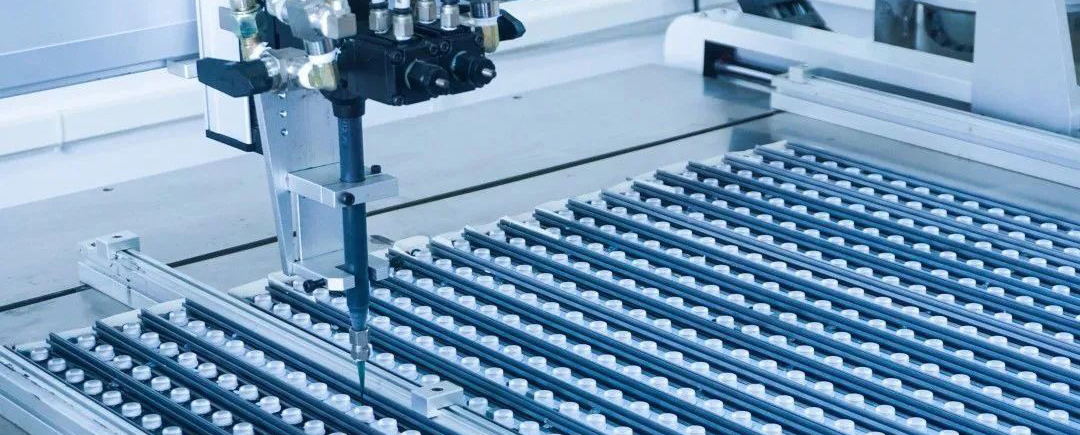1. Introduction
As LED display screen applications become more widespread, the demands for product quality and display performance have increased. Traditional SMD technology can no longer meet the needs of some applications. Therefore, some manufacturers are shifting to new encapsulation methods like COB technology, while others are improving upon SMD technology. GOB technology is an iteration of the improved SMD encapsulation process.
The LED display industry has developed various encapsulation methods, including COB LED displays. From the earlier DIP (Direct Insertion Package) technology to SMD (Surface-Mount Device) technology, then to the emergence of COB (Chip on Board) encapsulation, and finally the advent of GOB (Glue on Board) encapsulation.
Can GOB technology enable wider applications for LED display screens? What trends can we expect in the future market development of GOB? Let’s move on.
2. What is GOB Encapsulation Technology?
2.1 GOB LED display is a highly protective LED display screen, offering waterproof, moisture-proof, impact-resistant, dustproof, corrosion-resistant, blue light-resistant, salt-resistant, and anti-static capabilities. They do not adversely affect heat dissipation or brightness loss. Extensive testing shows that the glue used in GOB even aids in heat dissipation, reducing the failure rate of LEDs, enhancing the stability of the display, and thus extending its lifespan.
2.2 Through GOB processing, the previously granular pixel points on the GOB LED screen’s surface are transformed into a smooth, flat surface, achieving a transition from point light source to surface light source. This makes the LED screen panel’s light emission more uniform and the display effect clearer and more transparent. It significantly enhances the viewing angle (nearly 180° horizontally and vertically), effectively eliminates moiré patterns, greatly improves product contrast, reduces glare and dazzling effects, and alleviates visual fatigue.

3. What is COB Encapsulation Technology?
COB encapsulation means directly attaching the chip to the PCB substrate for electrical connection. It was primarily introduced to solve the heat dissipation problem of LED video walls. Compared to DIP and SMD, COB encapsulation is characterized by space-saving, simplified encapsulation operations, and efficient thermal management. Currently, COB encapsulation is mainly used in fine pitch LED display.
4. What Are the Advantages of COB LED Display?
Ultra-thin and Light: According to customer needs, PCB boards with thicknesses ranging from 0.4 to 1.2mm can be used, reducing weight to as little as one-third of traditional products, significantly lowering structural, transportation, and engineering costs for customers.
Impact and Pressure Resistance: COB LED display encapsulates the LED chip directly in the concave position of the PCB board, then encapsulates and cures it with epoxy resin glue. The surface of the light point protrudes, making it smooth and hard, impact-resistant, and wear-resistant.
Wide Viewing Angle: COB encapsulation uses a shallow well spherical light emission, with a viewing angle greater than 175 degrees, close to 180 degrees, and has excellent optical diffused light effects.
Strong Heat Dissipation: COB LED screen encapsulates the light on the PCB board, and the copper foil on the PCB board quickly conducts the heat of the light core. The copper foil thickness of the PCB board has strict process requirements, coupled with gold-plating processes, almost eliminating severe light attenuation. Thus, there are few dead lights, greatly extending the lifespan.
Wear-Resistant and Easy to Clean: COB LED screens surface of the light point protrudes into a spherical shape, making it smooth and hard, impact-resistant and wear-resistant. If a bad point appears, it can be repaired point by point. There is no mask, and dust can be cleaned with water or cloth.
All-Weather Excellence: Triple protection treatment provides outstanding waterproof, moisture-proof, corrosion-proof, dustproof, anti-static, oxidation, and UV resistance. It can operate normally in temperature environments ranging from -30°C to 80°C.

5. What is the Difference Between COB and GOB?
The main difference between COB and GOB lies in the process. Although COB encapsulation has a smooth surface and better protection than traditional SMD encapsulation, GOB encapsulation adds a glue application process to the screen surface, enhancing the stability of LED lamps and greatly reducing the likelihood of light drops, making it more stable.
6. Which is More Advantageous, COB or GOB?
There is no definitive answer to which is better, COB LED display or GOB LED display, as the quality of an encapsulation technology depends on various factors. The key consideration is whether you prioritize the efficiency of the LED lamps or the protection offered. Each encapsulation technology has its advantages and cannot be judged universally.
When choosing between COB and GOB encapsulation, it is important to consider the installation environment and operating time. These factors impact cost control and the differences in display performance.
7. conclusion
Both GOB and COB encapsulation technologies offer unique advantages for LED displays. GOB encapsulation enhances the protection and stability of the LED lamps, providing excellent waterproof, dustproof, and anti-collision properties, while also improving heat dissipation and visual performance. On the other hand, COB encapsulation excels in space-saving, efficient heat management, and providing a lightweight, impact-resistant solution. The choice between COB and GOB encapsulation depends on the specific needs and priorities of the installation environment, such as durability, cost control, and display quality. Each technology has its strengths, and the decision should be made based on a comprehensive evaluation of these factors.
If you are still confused about any aspect, contact us today. RTLED is committed to providing the best LED display solutions.
Post time: Aug-07-2024


